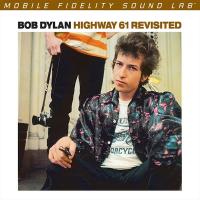Highway 61 Revisited Revisited By Mobile Fidelity at 45rpm
Bringing It All Back Home and "Subterranean Homesick Blues" may have pricked the thick, redneck skin of America's straight mainstream, but this album released late summer of 1965 was the mortal wound that changed the perspective of America's youth and sent the mainstream reeling even as the electricity shocked Dylan's early supporters and left them recoiling in disgust.
Like The Beatles from this period we're left today wondering how the previous album could have led to this one. Other than pot smoke, what was in the air? Dylan's liner notes may explain it but has anyone, including Dylan, yet figured out what he's saying in that annotation? Long live the mouths!
Dylan's once gravel-y, world-weary old man's voice became a nasty, nasally sarcastic snarl that could cut through the hardest rock backdrop, here provided by Mike Bloomfield, Al Kooper Charley McCoy and Russ Savakus among others. A year earlier Savakus had played bass on Ian & Sylvia's folk classic Northern Journey. That couldn't have prepared him (or anyone else in that studio) for this!
The vitriol Dylan spews on the "Like A Rolling Stone", combined with the hard rocking backdrop and its length make for an unlikely hit single and Columbia was hesitant to issue it as such but it leaked out and demanded release, hitting number two on the Billboard charts. The handwritten manuscript written on hotel stationary sold last week for two million dollars.
On "Tombstone Blues" Dylan spits lines like "the sun's not yellow it's chicken" and populates the surreal environment with Paul Revere's horse, Jack the Ripper, the outlaw Belle Starr and a doctor who advises the hysterical bride who's just been made "to not let the boys in." Good idea!
"It Takes A Lot to Laugh, It Takes a Train to Cry" and "From a Buick 6" continue the pattern of basic blues overloaded with surreal, disturbing lyrical spew and then Dylan throws down the gauntlet to straight America (which at the time probably included large swaths of his audience) with the truly disturbing, ridicule-laden "Ballad of a Thin Man". Talk about a song that resonated with the era's young people—or at least those who sensed that something unusual was rumbling in the cultural undergrowth. Madras shorts wearing, crew cut college kids in frat houses were playing the record, innocently singing along and before they knew what was happening, finding themselves unmoored from what they had assumed was solid ground.
"When your mother sends back all your invitations /and your father to your sister he explains/that you’re tired of yourself and all of your creations" could be Dylan's personal complaint but what to the listener seemed unlikely as a personal experience, for many soon became very real as alienation, rejection and disgust became commonplace.
The title tune comically alludes to a magical road where even the most difficult of challenges could be solved including selling forty red white and blue shoe strings and a thousand telephones that don't ring. Even the next world war could be successfully promoted—all you have to do is put some bleachers out in the sun on Highway 61.
For a generation brought up mostly on love songs these images, like a Salvador Dali painting both disturbed and delighted listeners. "Here is your throat back thanks for the loan" sums up how many exhausted listeners felt once the arm on their Silvertone record changer had returned to its rest.
Where the master tape went is anyone's guess because it is gone. Was it used for the 2003 SACD set? Or for DCC Compact Classic's gold CD edition? DCC claims yes, so where did go from there? Back to "Iron Mountain" where Columbia/Sony stores its tapes?
If so where did it go from there that it got lost? No use crying over lost tapes....wait a minute! Hell yes, there's plenty to cry over when tapes like this get lost. The loss of this one is disgusting because you can bet your left ball that it's on the shelf of some rich fuck who paid someone plenty for it.
We have the stationery on which Dylan wrote "Like A Rolling Stone" but the master tape is "missing"? I don't believe it is "missing". Someone has it.
Mobile Fidelity cut this double 45 from, as they say, "the best available (analog) source but they are not saying what that is. The original 1A pressing of this album is now "the master tape" and it contains a different version of "From a Buick 6" than is here, or is on most pressings. It's faster and higher in energy and why it was removed and replaced with a slower version is anyone's guess including at this point probably Dylan himself.
The point is: if you have an original 1A pressing you're set. It has an organic fullness and midband cohesion that this otherwise excellent double 45 lacks, though this mastering, somewhat brighter and instrumentally more separated, has its own sonic attractiveness. Interestingly, the DCC Compact Classic CD sounds timbrally and texturally closer to the 1A pressing than does this double 45 LP, though it too has the slower "From a Buick 6". It still sounds like a CD though.
Listening to this double 45 you'll kind of know you're not listening to a master tape or even to a copy thereof, in my opinion, but as with The Band's second album, Mobile Fidelity's high resolution mastering chain works its own magic so unless you can get a clean original 1A, 1B or so this one's the one. I have a 1A a 1B and a 2B. The 2B gives way to this reissue. And there you have it: something is happening but you don't know what it is.




